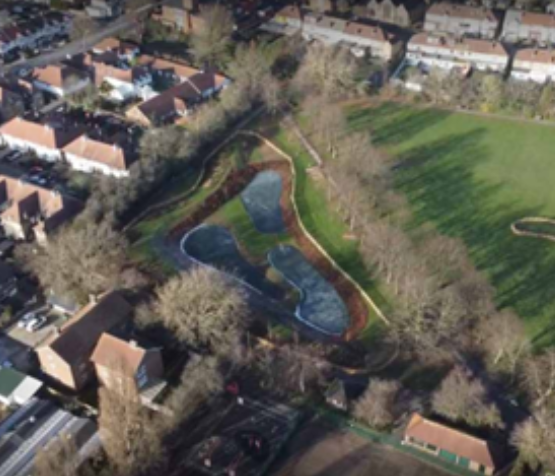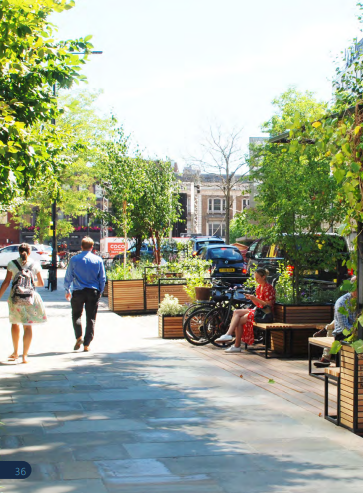In 2019, the UK Parliament declared a state of climate emergency. With the UN saying we could have just 11 years left to limit a climate change catastrophe. Climate change: What is a climate emergency? – BBC News
Rising temperatures are causing a major decrease in biodiversity as well as several issues with the world water systems, increasing flood risks and compromising air and water quality. This is especially true in the so called “urban heat islands”.
Recently, climate change experts have defined urban heat islands as the phenomenon of highly populated cities, which are experiencing higher air temperatures than the countryside. One of the main reasons for this is the high amount of hard landscaping and concrete that gets used for new developments in cities. This absorbs lots of heat and releases it back to buildings and the environment.
Large cities like London are affected by the urban heat phenomenon. “London is a growing city. By 2050 it is expected that up to three million more people will live there. (Urban greening | London City Hall). Hence, the government, engineers, and architects must work hard to reduce the effects of this on people and the environment.
The 2018 London Environment Strategy stated that we need to increase green areas within the built environment. And we need to do it fast. The document also included policies around Healthy Streets and Sustainable Drainage Action Plans having a direct impact on climate resilience.
Creating greener streets
Adding greening elements to cities’ buildings, pavements and roofs is one of the best ways to reduce the urban heat island effect. Due to high-density developments in cities, we are losing even more biodiversity and unbalancing natural ecosystems. In November 2022, the UK government published the Biodiversity Net Gain strategy, requiring developers and local authorities to demonstrate an increase in at least 10% of biodiversity in their development plans (Marston Holdings).
Other than increasing biodiversity, plants are incredibly important to absorb heat and carbon emissions, helping to clean air and water. They also play a significant role in increasing the urban spaces’ attractiveness, making it look welcoming and safer. Overall, green spaces increase the economic value of a city, with houses and neighbourhoods’ prices being noticeably higher when they are close to parks and green areas.
Implementing Healthy Streets and Sustainable Drainage Systems (SuDs)
Urban greening elements and better active travel infrastructure are core elements of the Healthy Streets guidance. This includes the idea of enabling the community to take on more sustainable modes of transport such as cycling and walking. When designing healthy streets, engineers must find a balance between implementing sustainable road measures and allowing communities to still access car and parking facilities.
Designing healthy streets also comprises of well-thought sustainable drainage systems and flood alleviation schemes. These play a significant role in slowing down storm water and filtering its quality. This is becoming fundamental as climate change is increasing flooding across the UK, causing damage to people and properties.
How can we help you?
Project Centre works with local authorities and private sector clients across the country to develop solutions that help your communities become more resilient to climate change. Below are just some of the many examples of our work.
South Chingford flood alleviation schemes
The London Borough of Waltham Forest commissioned us to provide landscape design and drainage services for three flood alleviation schemes in South Chingford.
The scheme not only addressed the surface water flooding issue, but it also contributed to several United Nation Sustainable Development Goals (SDGs), including:
- SDG 3 (Good Health and Well-being)
- SDG 4 (quality Education)
- SDG 6 (Clean Water and Sanitation)
- SDG 11 (Sustainable Cities and communities)
- SDG 13 (Climate Action)
- SDG 15 (Life on Land)

From installing rain gardens, permeable paving and underground storage tanks, to engaging with the community to create wetlands and attenuation basins, our team developed a comprehensive approach to address flooding. The alleviation schemes in Memorial Park, Larkswood Park and the Rolls Sport Centre provide a combined flood attenuation of over 5000m3.
Our projects have also given residents the opportunity to increase their interaction with wildlife. Through improving local parks, as well as creating a space for socialising, contemplation, and recreation. Recently, our Waltham Forest schemes have won the Highways Award for Winter Service and Climate Resilience.
Greening Hammersmith Grove

This scheme introduces ‘light touch’ streetscape elements (parklets) to substantially transform the character and use of the town centre. This responds to the ambitious agenda of the London Borough of Hammersmith and Fulham becoming ‘the greenest borough in the country’. The scale of this project is substantial, with multiple parklets being introduced in a relatively small area.
The project also includes new electric vehicle charging points and changes to the kerb alignment. This contributes to lowering carbon emissions as well as creating a safer and more sustainable urban environment.
Eastcote rain gardens
Our multi-disciplinary team created a place to respond to the Council’s placemaking aspirations whilst reducing frequent surface water flooding. We designed 15 rain gardens to capture and treat storm water.
Our project received a lot of positive feedback from residents on the enhanced environmental and aesthetic value.




